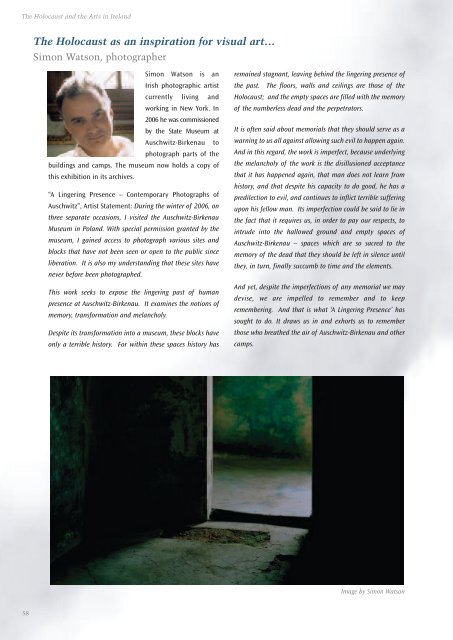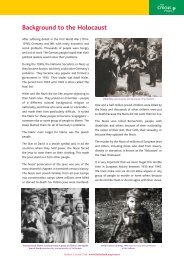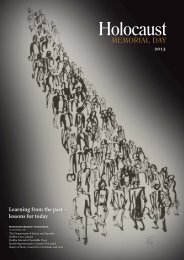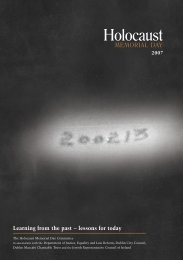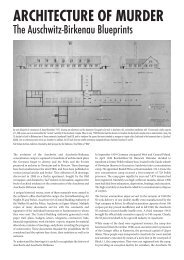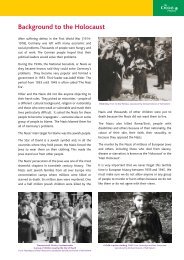Learning from the past ~ lessons for today - Holocaust Education ...
Learning from the past ~ lessons for today - Holocaust Education ...
Learning from the past ~ lessons for today - Holocaust Education ...
Create successful ePaper yourself
Turn your PDF publications into a flip-book with our unique Google optimized e-Paper software.
The <strong>Holocaust</strong> and <strong>the</strong> Arts in Ireland<br />
The <strong>Holocaust</strong> as an inspiration <strong>for</strong> visual art…<br />
Simon Watson, photographer<br />
Simon Watson is an<br />
Irish photographic artist<br />
currently living and<br />
working in New York. In<br />
2006 he was commissioned<br />
by <strong>the</strong> State Museum at<br />
Auschwitz-Birkenau to<br />
photograph parts of <strong>the</strong><br />
buildings and camps. The museum now holds a copy of<br />
this exhibition in its archives.<br />
“A Lingering Presence – Contemporary Photographs of<br />
Auschwitz”, Artist Statement: During <strong>the</strong> winter of 2006, on<br />
three separate occasions, I visited <strong>the</strong> Auschwitz-Birkenau<br />
Museum in Poland. With special permission granted by <strong>the</strong><br />
museum, I gained access to photograph various sites and<br />
blocks that have not been seen or open to <strong>the</strong> public since<br />
liberation. It is also my understanding that <strong>the</strong>se sites have<br />
never be<strong>for</strong>e been photographed.<br />
This work seeks to expose <strong>the</strong> lingering <strong>past</strong> of human<br />
presence at Auschwitz-Birkenau. It examines <strong>the</strong> notions of<br />
memory, trans<strong>for</strong>mation and melancholy.<br />
Despite its trans<strong>for</strong>mation into a museum, <strong>the</strong>se blocks have<br />
only a terrible history. For within <strong>the</strong>se spaces history has<br />
remained stagnant, leaving behind <strong>the</strong> lingering presence of<br />
<strong>the</strong> <strong>past</strong>. The floors, walls and ceilings are those of <strong>the</strong><br />
<strong>Holocaust</strong>; and <strong>the</strong> empty spaces are filled with <strong>the</strong> memory<br />
of <strong>the</strong> numberless dead and <strong>the</strong> perpetrators.<br />
It is often said about memorials that <strong>the</strong>y should serve as a<br />
warning to us all against allowing such evil to happen again.<br />
And in this regard, <strong>the</strong> work is imperfect, because underlying<br />
<strong>the</strong> melancholy of <strong>the</strong> work is <strong>the</strong> disillusioned acceptance<br />
that it has happened again, that man does not learn <strong>from</strong><br />
history, and that despite his capacity to do good, he has a<br />
predilection to evil, and continues to inflict terrible suffering<br />
upon his fellow man. Its imperfection could be said to lie in<br />
<strong>the</strong> fact that it requires us, in order to pay our respects, to<br />
intrude into <strong>the</strong> hallowed ground and empty spaces of<br />
Auschwitz-Birkenau – spaces which are so sacred to <strong>the</strong><br />
memory of <strong>the</strong> dead that <strong>the</strong>y should be left in silence until<br />
<strong>the</strong>y, in turn, finally succumb to time and <strong>the</strong> elements.<br />
And yet, despite <strong>the</strong> imperfections of any memorial we may<br />
devise, we are impelled to remember and to keep<br />
remembering. And that is what ‘A Lingering Presence’ has<br />
sought to do. It draws us in and exhorts us to remember<br />
those who brea<strong>the</strong>d <strong>the</strong> air of Auschwitz-Birkenau and o<strong>the</strong>r<br />
camps.<br />
Image by Simon Watson<br />
58


